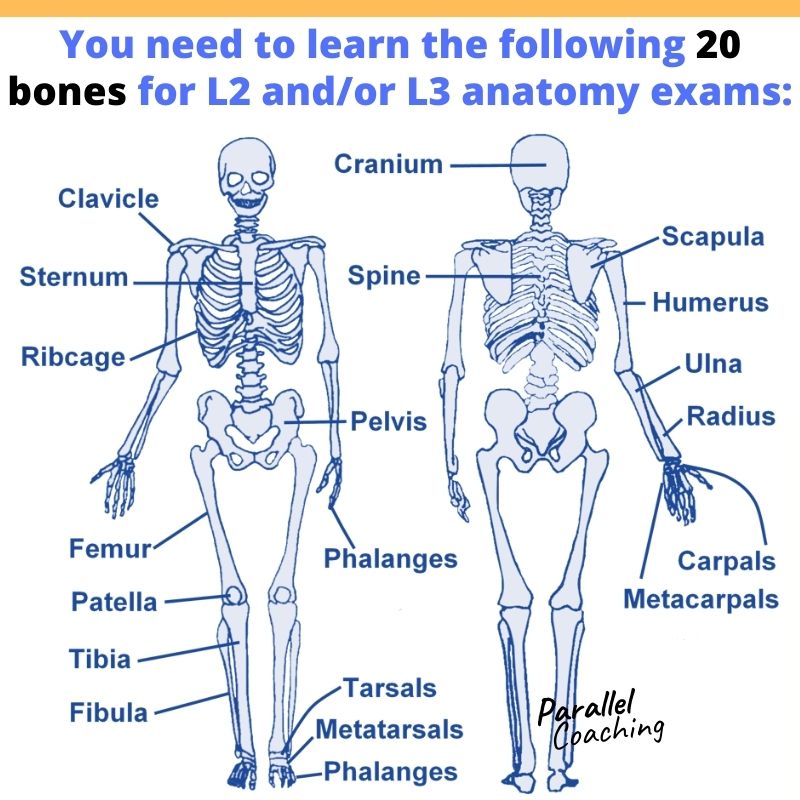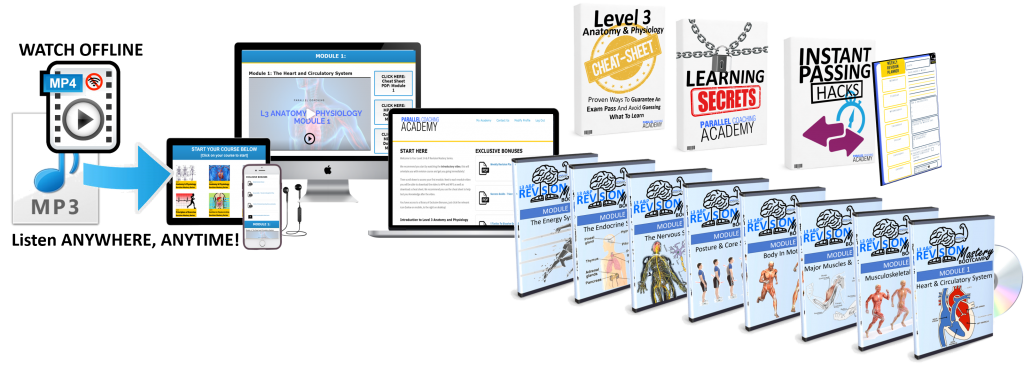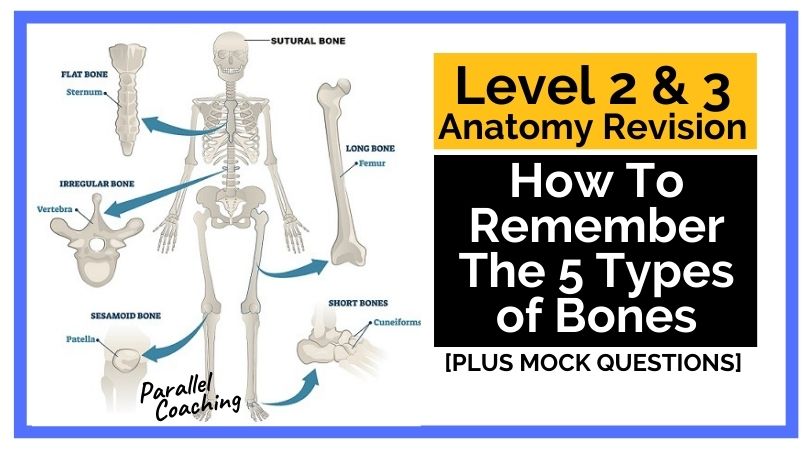In today’s video training, you’ll learn an acronym to remember the 5 Types of bones in the body for your Level 2 or Level 3 Anatomy and Physiology Exam
You’ll discover:
- What do you need to know about bones for Level 2 and Level 3?
- 8-minute Video Training outlining how to learn bones
- Acronym To Remember The 5 Types of Bones
- Test your knowledge with 3 Mock Questions and answers
What do you need to know about bones for Level 2 and Level 3?
There are 206 bones in the body. You need to know twenty bones and their TYPE for both the Level 2 and Level 3 anatomy and physiology exam.
You need to know a few key characteristics of each bone in preparation for your Level 2 or 3 Anatomy and Physiology Exam
- the 5 Types of Bones
- The name and location of 20 bones
- Which Type of bone is each bone
This is a lot of information to remember if you are trying to remember it word for word. That’s why we put together an acronym to Remember The 5 Types of Bones and locations
Watch: How To Remember The 5 Types of Bones
How To Remember The 5 Types of Bones
This acronym will simplify and structure how you are learning the key bones information. This is not only great for your exam, but also when planning and working with clients.
The Acronym
- F = Flat
- I = Irregular
- L = Long
- S = Short
- S = Sesamoid
Use the word FILSS as the basis to jog your memory about the types of bones
TOP TIP: When you see an exam questions that asks about the TYPE of bones in the body – jot down (or remind yourself of FILSS), then use this to remind you of each of the 5 types.
The next step is to associate the TYPE of bones to a set of characteristics and individual bones

Characteristics and Examples Bone Types
Using the acronym to remember each bone type is great, but let’s now link bone types to a set of charcteristics and individual examples so you can remember them.
With each of the examples below, touch that bone on your body and feel how the bone type and characteristics are consistent.
Flat Bones
Flat bones are thin, flattened, and usually curved. Most of the bones of the skull are flat bones. The primary role of a flat bone is large surface area to allow for attachment points.
Examples Include: The scapula (shoulder blade), The Sternum (front of rib cage), The Ilium (Large pelvic bone), The Ribs
All of these are flat to allow for lots of muscle attachments and add shape to the body
Irregular Bones
Bones that aren’t any of the other four categories are classified as irregular bones. These serve a very specific purpose and are required to be irregular in shape.
Examples Include: The vertebrae (bones of the spine), The Sacrum (looks flat but is irregular due to holes and curve)
L = Long
Bones that are longer than they are wide are called long bones. They consist of a long shaft with two bulky attachment points. The main role of a long bone is leverage for movement. Find out more about the structure of a long bone here.
Examples Include: The Femur (thigh bone), Metacarpals (palm of hand), Phalanges (fingers and toes), Ulna (forearm)
S = Short
Short bones are roughly cube shaped which creates stability and strength when grouped together. For example the Tarsals in the foot are Short bones. Learn the 5 tarsals of the foot here.
Examples Include: The Tarsals (foot/ankle), The Carpals (hand/wrist)
S = Sesamoid
The word “sesamoid” means “sesame seed” which is a good way to see this seed like bone embedded in a tendon
Examples Include: The Patella (Knee cap), The First Metatarsal Sesamoid (A pea sized bone under the big toe joint)
Learn 20 Bones For L2 and/or L3 Anatomy and Physiology Exam
The image below shows all 20 bones you need to know the name and location of for both exam levels.

Test your knowledge with 3 Mock Questions
Look at the Bones Anatomy and Physiology Mock questions below and jot down your answer on scrap paper or as a note in your phone.
Then scroll down to reveal the answers.
1) Which of the following is a type of Short Bone?
A. Metacarpals
B. Carpals
C. Femur
D. Phalanges
2) Which is the main function of a flat bone like the sternum?
A. Stability
B. Allow for Greater Movement
C. Attachment Sites for Muscles
D. Protection
3) Which Type of Bones is most likely to be found in the spine?
A. Smooth
B. Irregular
C. Flat
D. Long
Answers:
Q1: Answer = B
Q2: Answer = C
Q3: Answer = B
If you want more mock questions like this, then you can download more Free Mock Questions: DOWNLOAD NOW
Need More Help with your Anatomy Exam Revision?
Discover How 6500+ Fitpros In Training Are Walking Into Their Exam With Confidence And Guaranteeing A Pass
Are you tired of staring at your manual and not knowing where to start?
Our revision mastery bootcamp breaks everything down into a clear and easy to follow structure.
You can download the videos to MP3 and MP4 to slice your revision time in half and finally understand the key principles of exercise.
This is not another course with more exams – it HELPS pass the course you’re already enrolled on!
“EVERYTHING You Need To Learn, Revise And Pass Your Fitness Exam”
If you want to get your revision structured, learn everything you need to know and feel confident on exam day, then click the link below:
https://revision.parallelcoaching.co.uk/fitness-exam-revision-courses

Dedicated to More
Hayley “Remember The 5 Types of Bones” Bergman
Parallel Coaching
P.S. You can also find us on the following platforms:
Instagram: https://www.instagram.com/parallelcoaching
Facebook: https://www.facebook.com/ParallelCoaching
Twitter: https://twitter.com/ParallelCoach
YouTube: http://bit.ly/2F1Z1bs
More Muscle Revision Blogs: HERE

